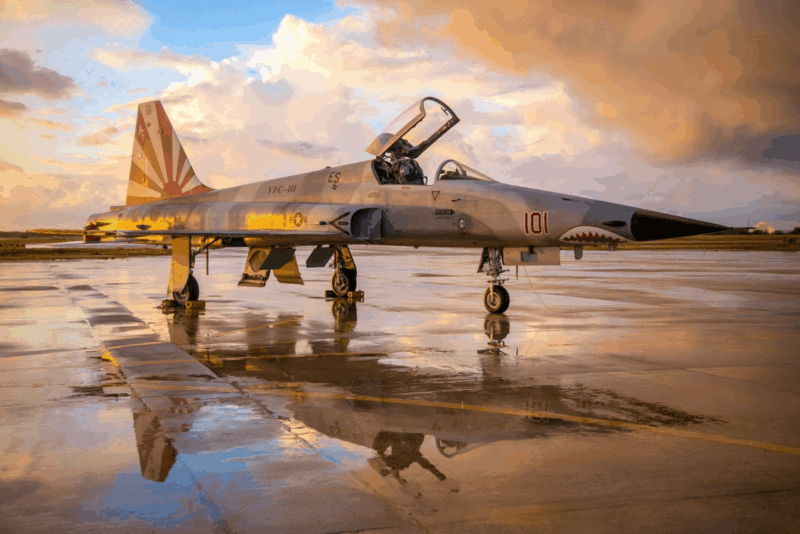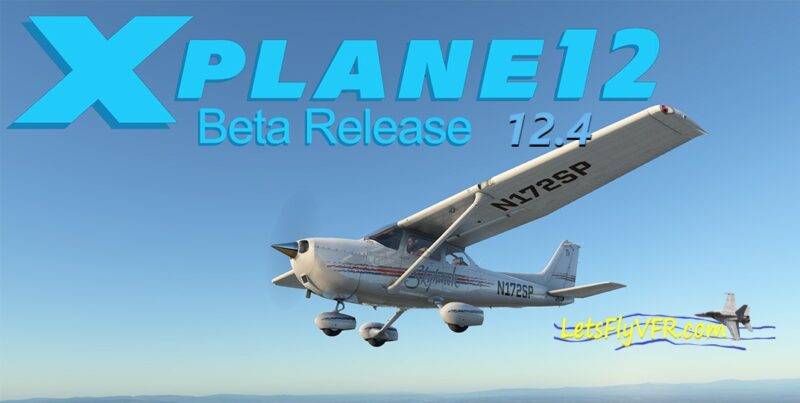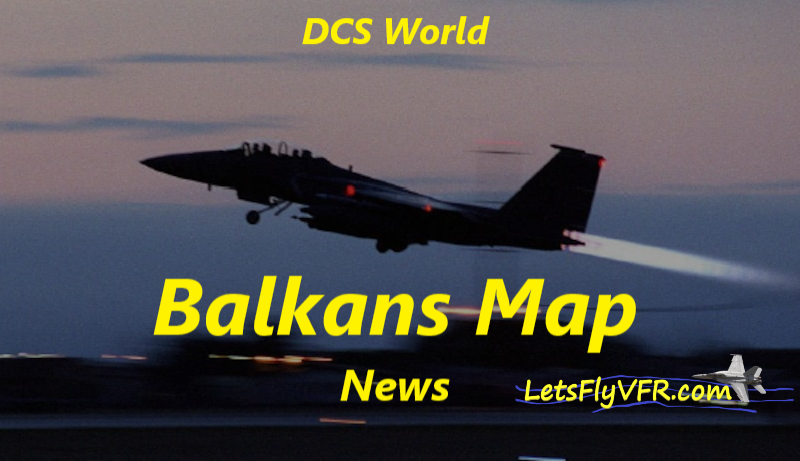DCS F-5E Tiger II: A Lightweight Multirole Fighter with Classic Charm.
Introduction DCS F-5E Tiger II
The Northrop F-5E Tiger II is a lightweight, highly maneuverable multirole fighter that has carved a unique niche in aviation history. Designed as a low-cost, high-performance aircraft, the F-5E remains a favorite in DCS World, offering a classic Cold War-era flying experience. It’s simple avionics, rugged airframe, and forgiving handling make it an excellent platform for both novice and experienced virtual pilots.
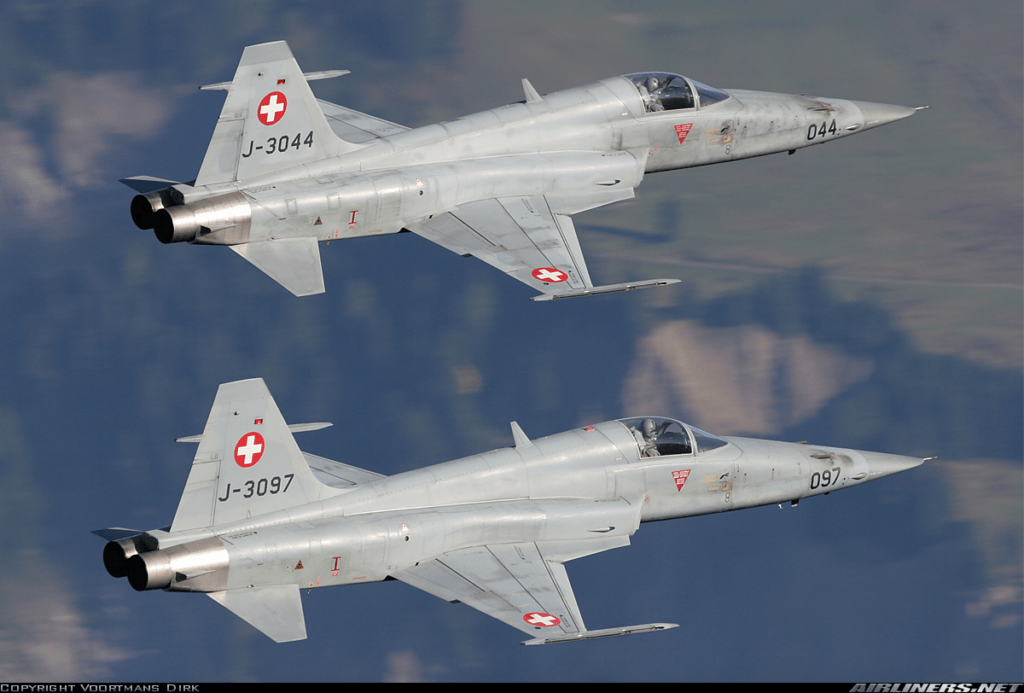
This post explores the F-5E’s performance, critical speeds, unique quirks, weapons systems, and role in combat flight simulators. We also include insights into its historical significance and real-world combat use, making it a must-read for DCS World and Falcon BMS enthusiasts.
History of the F-5E Tiger II
The F-5 was developed in the 1950s by Northrop as a simple, cost-effective alternative to larger and more expensive fighter jets. Its predecessor, the F-5A Freedom Fighter, gained wide acclaim for its reliability and agility. The F-5E Tiger II, introduced in 1972, was an upgraded variant featuring improved engines, avionics, and weapons capacity.
Used extensively by U.S. allies under the Mutual Defense Assistance Act, the F-5E became the backbone of many smaller air forces. Its affordability, ease of maintenance, and versatility made it a success, with over 1,400 units built and operational in over 30 countries.
Today, the F-5E is widely recognized as a “Red Air” adversary trainer, simulating enemy aircraft in mock combat scenarios.
Introduction DCS F-5E Tiger II – Performance Specifications
The F-5E’s design emphasizes simplicity and performance, with twin engines providing robust thrust and a lightweight airframe ensuring exceptional agility.
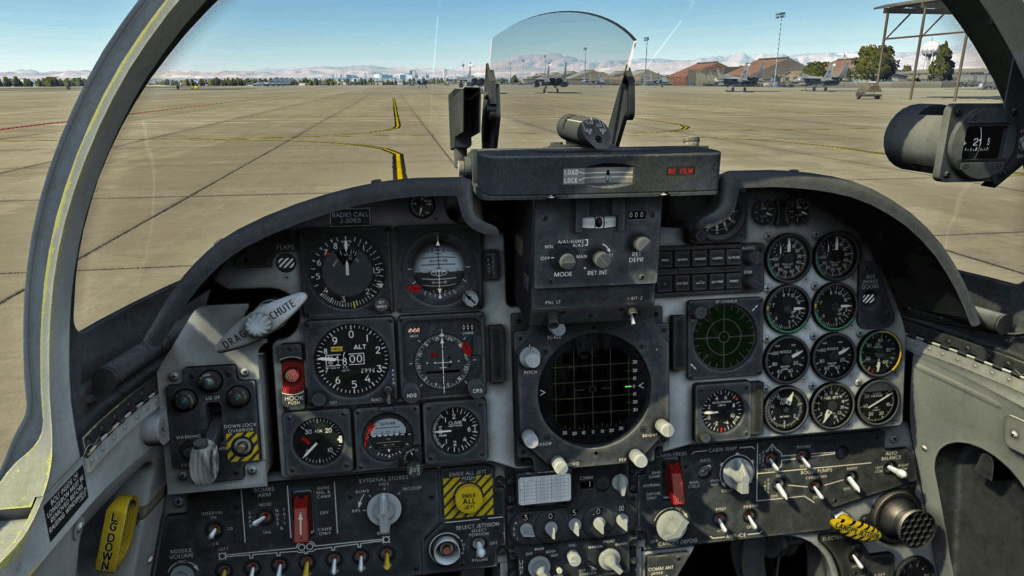
- Engines: 2 x General Electric J85-GE-21B turbojets (5,000 pounds of thrust each with afterburner)
- Max Speed:
- Mach 1.63 (~1,000 knots) at altitude
- ~700 knots at sea level
- Service Ceiling: 51,800 feet
- Rate of Climb: ~34,400 feet per minute
- Range:
- 760 nautical miles (internal fuel, ferry range)
- ~300–400 nautical miles (combat radius with external tanks)
- Fuel Capacity:
- Internal: 2,292 liters (~605 gallons)
- External: Up to three drop tanks (275 or 330 gallons each)
The F-5E is particularly well-suited to short-range air defense and close air support missions, though its limited range and payload require careful mission planning.

Critical Speeds and Combat Performance
- Optimal Cruise Speed: ~400 knots at 35,000 feet.
- Corner Speed (Best Instantaneous Turn): ~400 knots.
- Best Sustained Turn Speed: ~350 knots.
- Takeoff Speed: ~150 knots (light load) or ~170 knots (heavy load).
- Landing Speed: ~145 knots (with flaps and gear).
The F-5E’s high thrust-to-weight ratio and low wing loading make it an agile and responsive aircraft in both dogfights and low-altitude strike missions. However, energy management is critical to maintaining its edge in prolonged engagements.
- Latest CPU’s Available Now – Amazon.com
- Get a NEW GPU Best Performance – AMAZON.com
- Upgrade RAM Here today – AMAZON.com
- Prebuilt PC Options – AMAZON.com
Introduction DCS F-5E Tiger II – Weapons and Avionics
The F-5E’s armament and avionics are simple but effective, offering a balanced mix of air-to-air and air-to-ground capabilities.

Armament
- Air-to-Air Missiles:
- AIM-9 Sidewinder (heat-seeking missile for close-range engagements)
- Air-to-Ground Ordnance:
- Mk-82 and Mk-83 bombs
- M117 general-purpose bombs
- LAU-3 rocket pods (7 rockets each)
- AGM-65 Maverick (air-to-ground missile for precision strikes)
- Gun: Twin M39A2 20mm cannons (280 rounds per gun)
Avionics
- AN/APQ-153 Radar: Basic ranging radar with limited tracking capability. Effective range: ~20 nautical miles.
- Manual Weapons Delivery: The F-5E requires pilots to rely on visual targeting and manual calculations for bomb and rocket employment.
- Basic HUD: Displays essential flight and targeting information.
- No ECM Systems: The lack of countermeasures makes the F-5E vulnerable to radar-guided threats, requiring defensive flying tactics.
Introduction DCS F-5E Tiger II – Known Flying Attributes
The F-5E Tiger II is known for its smooth handling and forgiving nature, but it also has distinct characteristics that set it apart:
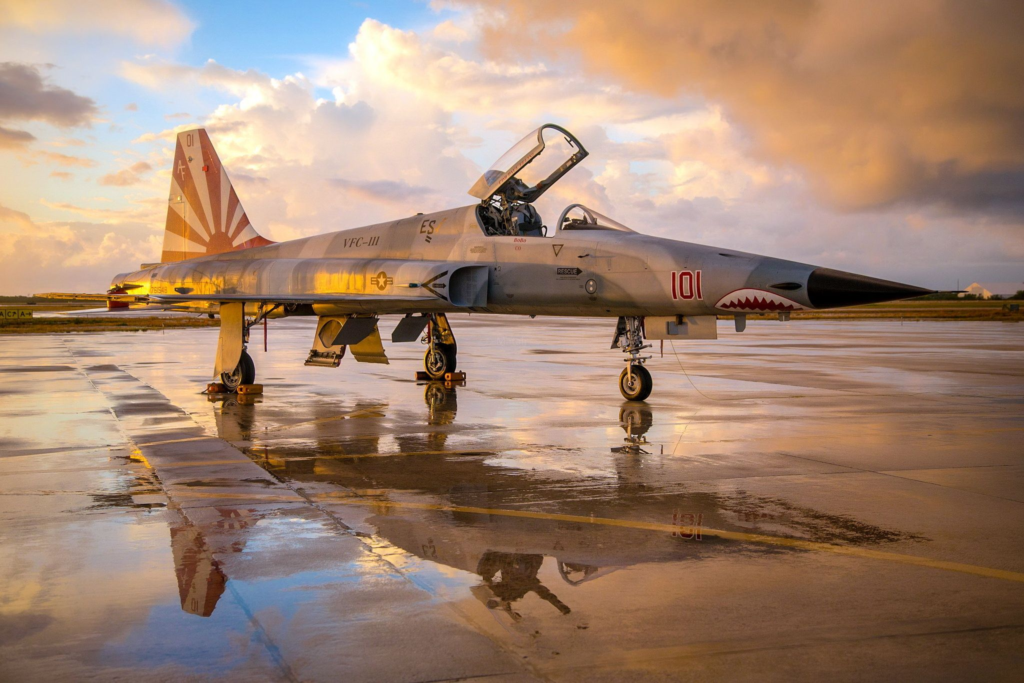
- Agility: The F-5E’s low wing loading allows it to perform tight turns, making it a formidable opponent in close-range dogfights.
- Simple Systems: The aircraft’s analog controls, and lack of automation make it an excellent platform for mastering basic fighter maneuvers (BFM).
- Limited Range: Like many light fighters, the F-5E’s range is restricted by its small internal fuel capacity. External tanks are essential for extended missions.
- Stable Low-Speed Handling: The F-5E is forgiving at low speeds, which aids in formation flying and landing.
Dangerous Maneuvers and Flight Considerations
While the F-5E is user-friendly, it has certain quirks and limitations that pilots must consider:
- Energy Management: The F-5E bleeds energy quickly in sustained turns. Avoid prolonged engagements that drain speed and altitude.
- Spin Risk: Aggressive inputs at low speeds or high angles of attack (AoA) can lead to unrecoverable spins. Pilots should maintain coordinated controls and avoid exceeding critical AoA.
- Low Altitude Combat: While maneuverable, the F-5E lacks modern countermeasures, making it vulnerable to surface-to-air missiles (SAMs) and anti-aircraft artillery.
- No Auto-Stabilization: Pilots must manually trim the aircraft for smooth flight, especially when carrying asymmetric loads.
Advanced Features in DCS World
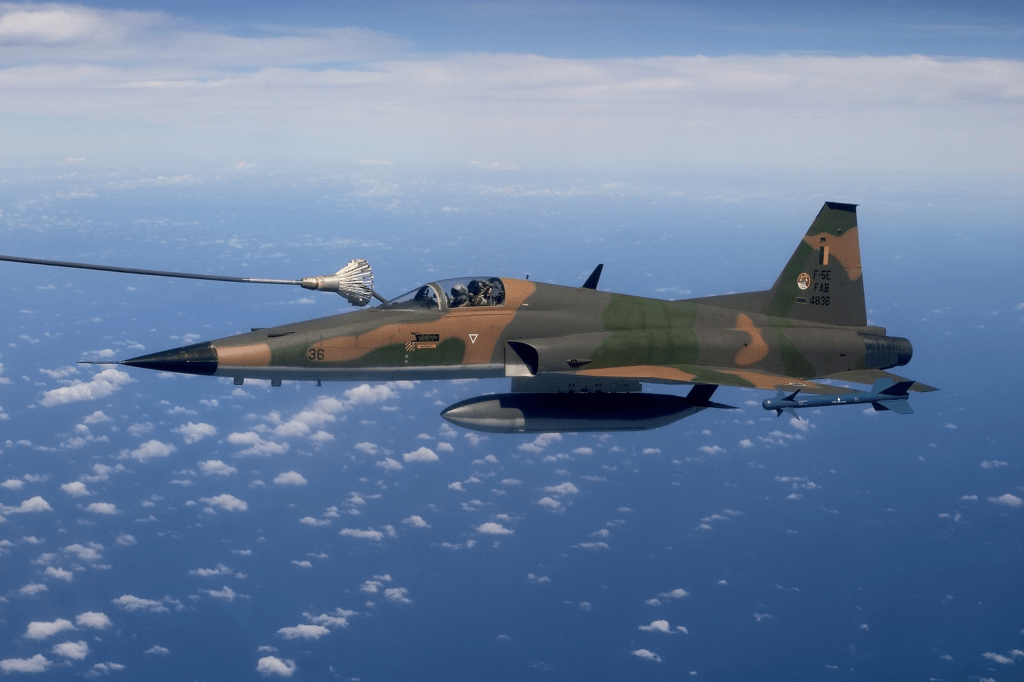
The F-5E Tiger II is faithfully recreated in DCS World, offering a detailed simulation of this iconic aircraft. Features include:
- Professional Flight Model (PFM): Captures the nuances of the F-5E’s performance, including its high-speed handling and stall characteristics.
- Clickable Cockpit: Allows full interaction with systems and switches.
- Training Missions: DCS includes tutorials to help players master the F-5E’s systems and weapons.
- VR Support: Enhances immersion, making the analog cockpit more engaging.
The F-5E’s Role in DCS and Falcon BMS
In DCS World, the F-5E excels as a trainer and light multirole fighter, offering a Cold War-era experience. Its simplicity makes it an ideal choice for pilots learning air-to-air and air-to-ground tactics. In Falcon BMS, the F-5E serves as an adversary in training missions or as a secondary combat platform in campaigns.


Pilot Operating Manual
For those looking to deepen their knowledge, the unclassified F-5E flight manual can be accessed CLICK HERE for REAL WORLD UNCLASSIFIED MANUAL.
Conclusion
The F-5E Tiger II is a classic fighter that continues to captivate pilots with its blend of simplicity, agility, and versatility. In DCS World, it’s a fantastic aircraft for mastering fundamental skills and enjoying Cold War-era combat scenarios. While it lacks the advanced systems of modern jets, its rugged design and balanced performance make it a joy to fly.
Whether you’re engaging in dogfights, delivering precision strikes, or just learning the basics of combat aviation, the F-5E delivers an authentic and rewarding experience. Dive into the Tiger II, and you’ll gain a newfound appreciation for the art of flying!
- Joystick / HOTAS – AMAZON.com
- Rudder Pedals – AMAZON.com
- Throttle Quadrant – AMAZON.com
- Gaming Chair – AMAZON.com
- VR Headset – AMAZON.com
Author

Brendon McAliece (Aka Gunnie) is a military veteran with 23 years working on Jet Fighters, their weapons systems and ejection seat/module systems as well as munitions and R&D. Involved with flight simulation since the 1980s, he has flown all the major flight simulators over the years.
He is an Australian expat who has lived in Malaysia, UK, Saudi Arabia and more recently Thailand. He is a multi-lingual blogger who loves to share his life experiences here on LetsFlyVFR.com and DreamingGuitar.com, with his lifestyle and Travel experiences Blog plus his Dreaming Coffee website.
Learn More @ DreamingGuitar.com – DreamingCoffee.com – LetsFlyVFR.com
( HOME – BLOG – SHOP – ABOUT )
As an Amazon affiliate I may benefit from qualifying sales.
